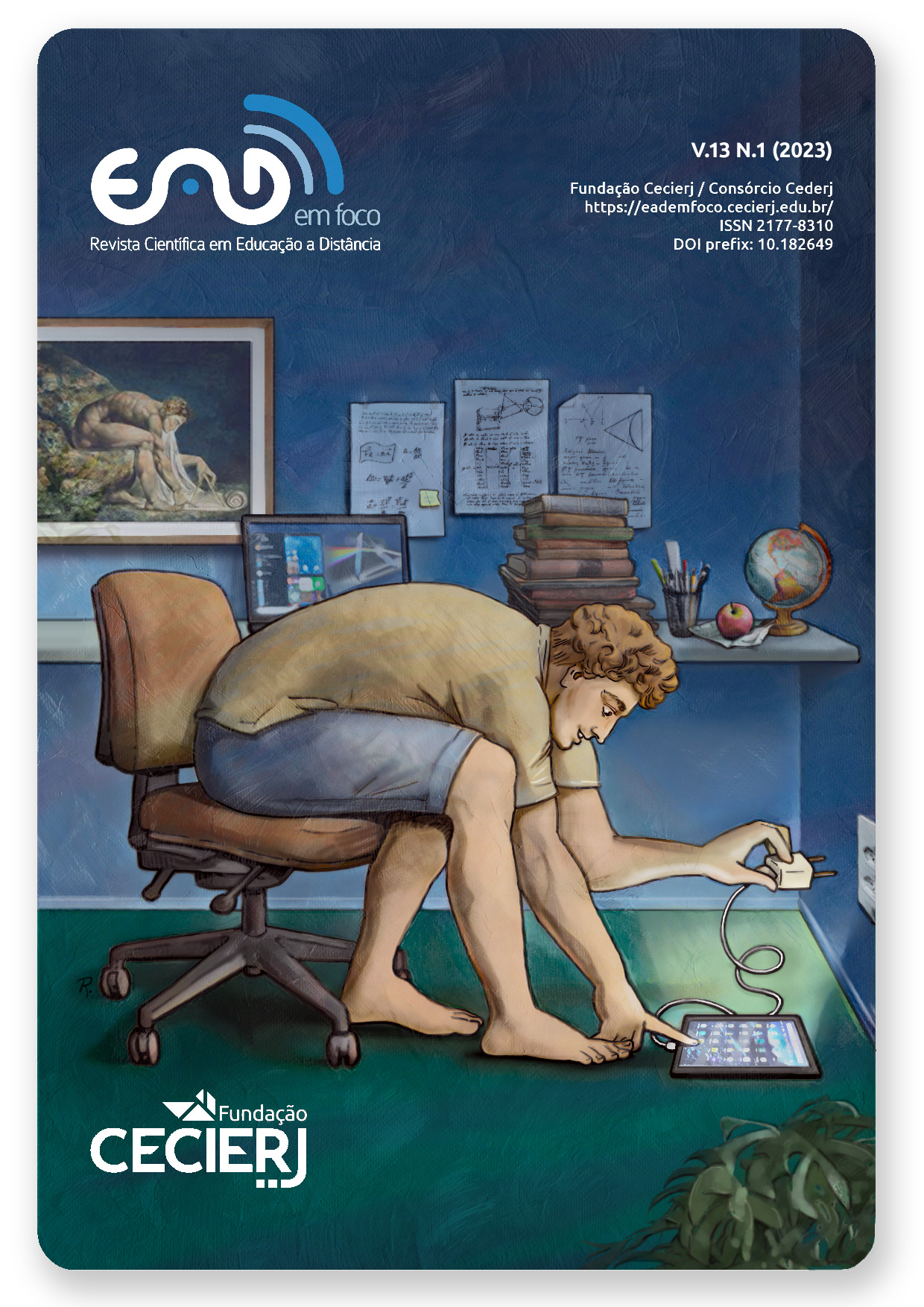Analysis of the Challenges in Distance Learning in UNIVESP's Mediation Activities
DOI:
https://doi.org/10.18264/eadf.v13i1.2000Keywords:
Education, Facilitator, Tutor, MediatorAbstract
Abstract. Distance Learning modality is a reality in Brazil, even before the numbers of courses and students increase significantly due to the Covid-19 pandemic. This growth allows access to higher education for thousands of Brazilians, and affects an important part of the national territory that, otherwise, might not have an Educational Institution. This work presents an analysis of the main challenges encountered by the facilitators at UNIVESP, considering qualitative research of the main aspects of improvement pointed out by the mediators themselves allocated as tutors in activities of the institution's undergraduate courses. The results obtained allow us to reflect on possible adjustments, capable of contributing positively to the experience of these individuals, as well as generating improvements in the training of undergraduate students who are under the responsibility of tutors.
Keywords: Education. Facilitator. EaD Tutor. Mediator.
Downloads
References
ABNT. Associação Brasileira de Normas Técnicas. NBR ISO 9001:2015. Sistemas de gestão da qualidade: Requisitos. 2015.
APARICIO, M.; BACAO, F.; OLIVEIRA, T. Cultural impacts on e-learning systems’ success Internet High. Education, n.31, p.58–70, 2016.
BRADFORD, G. R. A relationship study of student satisfaction with learning on-line and cognitive load: Initial results. The Internet and Higher Education, vol. 14, n.4, p.217–226, 2011.
BRASIL. Ministério da Educação. O que é educação a distância? 2016. Disponível em: http://portal.mec.gov.br/escola-de-gestores-da-educacao-basica/355-perguntas-frequentes-911936531/educacao-a-distancia-1651636927/12823-o-que-e-educacao-a-distancia - Acesso em: 8 de Set. de 2022.
CHEAWJINDAKARN, B.; SUWANNATTHACHOTE, P.; THEERAROUNGCHAISRI, A. Critical success factors for on-line distance learning in higher education: a review of the literature. Creative Education, Vol. 3, n.8, p.61-66, 2012.
EHLERS, U. Quality in e-Learning from a Learner’s Perspective. European Journal of Open, Distance and E-Learning, n.23, outubro 2018. Oldenburg, Germany. 2018.
GOODMAN, E.; KUNIAVSKY, M.; MOED, A. Observing the user experience: a practitioner's guide to user research. 2nd ed. Amsterdam: Elsevier, Morgan Kaufmann, 2012.
GOKCE, S. Um guia para o feedback dos usuários: como coletar e usar. 2022. Disponível em: https://userguiding.com/pt-br/blog/feedback-dos-usuarios - Acesso em: 16 de Out. de 2022.
HASSENZAHL M. et al. Experience-oriented and product-oriented evaluation: psychological need fulfillment, positive affect, and product perception. International Journal of Human Computer Interaction. 2015, v.31, n.8, p. 530–544. 2015.
HASSENZAHL, M. User Experience (UX): Towards an experiential perspective on product quality. 2008. Não paginado. Disponível em: http://www.marc-hassenzahl.de/pdfs/hassenzahl-ihm08.pdf - Acesso em: 10 abr 2021.
INEP. Instituto Nacional de Estudos e Pesquisas Anísio Teixeira. Censo da Educação Superior 2019. Disponível em: https://www.gov.br/inep/pt-br/areas-de-atuacao/pesquisas-estatisticas-e-indicadores/censo-da-educacao-superior/resultados - Acesso em: 22 fevereiro de 2021.
ISONORM. International Organization for Standardization. Ergonomics of human-system interaction. Part 11: Usability: Definitions and concepts. 2018. Disponível em: https://www.iso.org/obp/ui/#iso:std:iso:9241:-11:ed-2:v1:en - Acesso em: 15 julho 2021.
KITCHENHAM, B.; CHARTERS, S. Guidelines for performing systematic literature reviews in software engineering. Technical Report EBSE 2007-001, Keele University and Durham University Joint Report, 2007.
KRIPPENDORFF, K. The semantic turn: a new foundation for design. Boca Raton: Taylor&Francis, 2006.
NAVIMIPOUR, N. J.; ZAREIE, B. A model for assessing the impact of e-learning systems on employees’ satisfaction. Computer Human Behavior, n.53, p. 475-485, 2015.
NIELSEN, J.; NORMAN, D. The Definition of User Experience. In: Nielsen Norman Group. Evidence-Based User Experience Research, Training, and Consulting. [site]. Fremont, CA, 2014. Disponível em: https://www.nngroup.com/articles/definition-user-experience - Acesso em: 20 jan. de 2021.
PARASURAMAN, A. et al. A Conceptual Model of Service Quality and Its Implications for Future Research. Journal of Marketing, n.49, p. 41-50. 1985.
PRESS, M.; COOPER, R. El diseño como experiência: el papel del diseño y los diseñadores en el siglo XXI. Barcelona: Gustavo Gili, 2009.
RABIN, E.; KALMAN, Y.; KALZ, M. An empirical investigation of the antecedents of learner-centered outcome measures in MOOCs. International Journal of Educational Technology in Higher Education. 2019.
REMATAL, D. R. C.; BEHAR, P. A.; MAÇADA, A. C. G. Elementos de gestão para educação a distância: um estudo a partir dos fatores críticos de sucesso e da visão baseada em recursos. Revista Renote - Novas tecnologias na educação. Rio Grande do Sul, v. 7, n. 1, julho, 2009. Disponível em: http://seer.ufrgs.br/renote/article/view/13974 - Acesso em: 12 jul. 2021.
RIVERO, L.; CONTE, T. A systematic mapping study on research contributions on UX evaluation technologies. In.: Proceedings of the 16th Brazilian Symposium on Human Factors in Computing Systems (IHC 2017), Joinville, Brazil. 2017.
SAFFER, D. Designing for interaction: creating smart application and clever devices. Berkeley: New Riders, 2007.
SCHIFFERSTEIN, H.; HEKKERT, P. Product Experience. London: Elsevier, 2008.
SHRAIM, K. Y. Quality Standards in On-line Education: The ISO/IEC 40180 Framework. iJET, vol. 15, n.19, 2020.
SWART, W.; WENGROWICZ, N.; WUENSCH, K. Using transactional distances to explore student satisfaction with group collaboration in the flipped classroom. International Journal of Information and Operations Management Education, vol.6, n.1, p. 24-48, 2015.
TULLIS T.; ALBERT B. Measuring the User Experience. Amsterdam: Morgan Kauffman, 2013.
VÄÄNÄNEN-VAINIO-MATTILA, K.; SEGERSTÅHL, K. A Tool for Evaluating Service User eXperience (ServUX): Development of a Modular Questionnaire. In.: Interact 2009 conference, User Experience Evaluation Methods in Product Development (UXEM'09), 2009. Proceedings. Workshop in Interact'09 conference, Uppsala, Sweden, 2009.
WENGROWICZ, N. et al. Students’ Collaborative Learning Attitudes and Their Satisfaction with On-line Collaborative Case-Based Courses. American Journal of Distance Education, p. 283-300. 2018.
WOOD, D. J. et al. Stakeholder Identification and Salience After 20 Years: Progress, Problems, and Prospects. Business & Society, 60(1), 196–245. 2021.
Downloads
Published
How to Cite
Issue
Section
License
Copyright (c) 2023 EaD em Foco

This work is licensed under a Creative Commons Attribution 4.0 International License.
All articles published in Revista EaD em Foco receive the license
Creative Commons - Atribuição 4.0 Internacional (CC BY 4.0).
All subsequent publications, complete or partial, must be made with the acknowledgment, in citations, of the Revista EaD em Foco as the original editor of the article.













